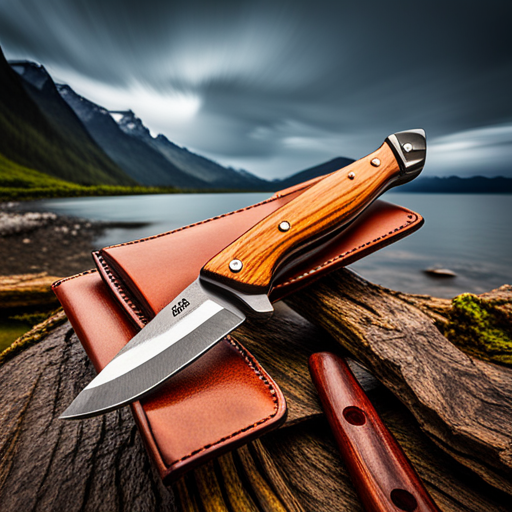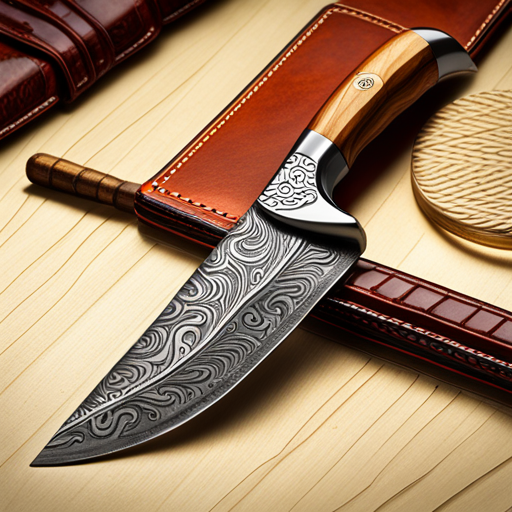
Making your own knife can be a rewarding and fulfilling experience. It takes patience, skill, and creativity to create a well-crafted blade. In this article, we’ll cover the basics of making a knife from scratch.
First, you’ll need to decide what type of steel you want to use for your blade. Common steel choices for knife-making include carbon steel, stainless steel, and tool steel. Each type of steel has its own advantages and disadvantages, so it’s important to do the research and decide which is right for you.
Next, you’ll need to measure and cut out the blade shape. You can use a blade template or make your own outline with a marker. Use a saw to cut it out and then file down the edges until you have the desired shape. You can also use an angle grinder to get into tight corners or create curved shapes.
Once you have the basic shape, it’s time to heat-treat your blade. Heat-treating adds strength and durability to the metal, which is necessary for a quality knife. You’ll need to follow the instructions for your particular type of steel when heat-treating.
Now it’s time to sharpen and polish your blade. Use an appropriate sharpening stone and water or oil to sharpen it and then use a fine-grade steel wool or polishing compound to buff the blade. Be sure to keep your knife clean throughout this process as any dirt or debris can ruin the finish and cause rusting.
Finally, you need to attach a handle if you want your knife to be useful. You can purchase a pre-made handle or you can make your own. If you decide to make your own handle, consider the type of material that will give a comfortable grip and will be strong enough to withstand heavy use. Once you’ve attached the handle, test it out by cutting through several materials to see how well it performs and if there are any areas you need to adjust.
Now all that’s left is to sharpen your knife and enjoy your new creation! If you’re feeling ambitious, you could even try creating a custom sheath for your knife. With the right materials and attention to detail, you can create a unique and useful tool that will last for years! With a little bit of know-how, some tools, and the right materials, anyone can make their own knife.
Different Types of Steel
When it comes to making a good knife, the type of steel used is incredibly important. There are numerous types of steel available for knife makers, each with its own unique qualities and advantages. Here we’ll discuss which type of steel makes the best knives and what characteristics to look for when choosing one.
High carbon steels are some of the most popular choices among knife makers due to their durability and strength. They can be hardened easily, which means they stand up well against wear and tear. The downside is that they can rust if not cared for properly, so they need regular maintenance such as oiling or regular cleaning. Some examples of high carbon steels include 1095, 5160, and O1.
Stainless steels are also popular among knife makers due to their corrosion-resistant properties. They hold up better in moist environments, making them ideal for kitchen knives. However, they’re not as hard or durable as high carbon steels and require more frequent sharpening. Common stainless steel options include 420HC, AUS-8, VG10, and 154CM.
Damascus steel is a type of steel created by folding two different types of metal together before forging it into shape. This creates a layered pattern on the surface which makes Damascus steel visually stunning. It’s not only beautiful but also incredibly strong and often used for chef knives and pocket knives.
Tool steels have been specially designed for use in tools such as knives, which require a high level of durability. They’re usually made from mixtures of iron and other metals such as chromium or tungsten, which makes them harder and more resistant to wear and tear than regular steel. Common tool steels include A2, D2, O1, and M2.
High carbon steel is an alloy that contains more carbon than low carbon steel. This extra carbon gives it excellent hardness and strength, making it ideal for making blades that need to hold an edge well. Common high carbon steels are 1095, 5160, 1084, O1, and W2.
No matter what type of steel you choose for your knife blade, be sure to do your research to make sure you’re getting the right type for your application. Different types of steel have different advantages and drawbacks, so it pays to be informed before making your purchase. Consider factors such as blade hardness, corrosion resistance, edge retention, and maintenance requirements when deciding which type of steel is best for you. With careful consideration, you can find the perfect knife steel that meets all your needs.
No matter what kind of knife you’re looking for—whether a chef’s knife or hunting knife—you can be sure that there’s a suitable high-quality steel out there to meet your needs. With the right information and care, you can rest assured that your knife will last many years and serve you faithfully.
Below are some of the most popular types of steel used for making knives, and a brief overview of their characteristics:
Carbon Steel – Carbon steel is an alloy made up primarily of iron and carbon. It’s extremely hard and durable, making it ideal for heavy-duty tasks such as butchering or splitting wood. However, carbon steel is also prone to corrosion if not properly maintained, so it’s important to clean the blade after every use and oil it regularly.
Stainless Steel – Stainless steel is an alloy composed mostly of chromium and iron. It offers good resistance to corrosion but isn’t quite as hard as carbon steel, so it may require more frequent sharpening. It’s also more expensive than carbon steel, but it will last longer with proper care.
High Carbon Stainless Steel – High-carbon stainless steel is a combination of both carbon and stainless steel, making it extremely durable and corrosion resistant. It’s often used in high-end kitchen knives due to its strength and performance. It can be slightly more difficult to sharpen than other types of steel, but its long-lasting durability makes it worth the extra effort.
Tool Steel – Tool steels are a type of high-performance alloy that’s specifically designed for use in tools such as knives or chisels. They offer excellent wear resistance and edge retention, making them perfect for tasks that require precision and accuracy. They can be made from either carbon steel or stainless steel, but the most common type of tool steel is a combination of both.

